Assessing Mechanical Properties of Jute, Kenaf, and Pineapple Leaf Fiber-Reinforced Polypropylene Composites: Experiment and Modelling
Abstract
:1. Introduction
2. Experimental Procedure
2.1. Materials
2.2. Composite Fabrication Process
2.2.1. Fabrication of PP Sheets
2.2.2. Fabrication of Composite Laminates
2.3. Fourier Transform Infrared (FTIR) Spectroscopy
2.4. Physical and Mechanical Characterization of Composites
2.4.1. Determination of fiber fractions
2.4.2. Determination of Tensile Properties
2.4.3. Determination of Flexural Properties
2.4.4. Determination of Impact Properties
2.5. Thermogravimetric Analysis of Composites
2.6. Fractured Surface Analysis Procedure
3. Results and Discussion
3.1. FTIR Analysis
3.2. Tensile Strength (TS)
3.3. Theoretical Calculation of Tensile MODULUS
3.4. Flexural strength (FS)
3.5. Impact Strength (IS)
3.6. Thermal Characteristics
3.7. Fractured Surface Morphology
4. Conclusions
Author Contributions
Funding
Institutional Review Board Statement
Informed Consent Statement
Data Availability Statement
Acknowledgments
Conflicts of Interest
References
- Sayem, A.S.M.; Haider, J. An Overview on the Development of Natural Renewable Materials for Textile Applications. In Encyclopedia of Renewable and Sustainable Materials, 1st ed.; Hashmi, S., Choudhury, I.A., Eds.; Elsevier: Oxford, UK, 2020; Volume 2, pp. 822–838. [Google Scholar]
- Sayeed, M.M.A.; Sayem, A.S.M.; Haider, J. Opportunities with Renewable Jute Fiber Composites to Reduce Eco-Impact of Nonrenewable Polymers. In Encyclopedia of Renewable and Sustainable Materials, 1st ed.; Hashmi, S., Choudhury, I.A., Eds.; Elsevier: Oxford, UK, 2020; Volume 2, pp. 810–821. [Google Scholar]
- Sayem, A.S.M.; Haider, J.; Sayeed, M.M.A. Development and characterisation of multi-layered jute fabric-reinforced HDPE composites. J. Compos. Mater. 2019, 54, 1831–1845. [Google Scholar] [CrossRef]
- Rahman, H.; Yeasmin, F.; Islam, T.; Hasan, M.; Uddin, M.; Khan, R.A. Fabrication and investigation of the physico-mechanical properties of Jute-PALF reinforced LLDPE hybrid composites: Effect of gamma irradiation. Heliyon 2022, 8, e09287. [Google Scholar] [CrossRef] [PubMed]
- Shahinur, S.; Hasan, M. Natural Fiber and Synthetic Fiber Composites: Comparison of Properties, Performance, Cost and Environmental Benefits. In Encyclopedia of Renewable and Sustainable Materials, 1st ed.; Hashmi, S., Choudhury, I.A., Eds.; Elsevier: Oxford, UK, 2020; Volume 2, pp. 794–802. [Google Scholar]
- Muflikhun, M.A.; Fiedler, B. Failure Prediction and Surface Characterization of GFRP Laminates: A Study of Stepwise Loading. Polymers 2022, 14, 4322. [Google Scholar] [CrossRef] [PubMed]
- Muflikhun, M.A.; Higuchi, R.; Yokozeki, T.; Aoki, T. Failure mode analysis of CFRP-SPCC hybrid thin laminates under axial loading for structural applications: Experimental research on strain performance. Compos. Part B Eng. 2019, 172, 262–270. [Google Scholar] [CrossRef]
- Nugraha, A.D.; Nuryanta, M.I.; Sean, L.; Budiman, K.; Kusni, M.; Muflikhun, M.A. Recent Progress on Natural Fibers Mixed with CFRP and GFRP: Properties, Characteristics, and Failure Behaviour. Polymers 2022, 14, 5138. [Google Scholar] [CrossRef]
- Shahinur, S.; Hasan, M. Jute/Coir/Banana Fiber Reinforced Bio-Composites: Critical Review of Design, Fabrication, Properties and Applications. In Encyclopedia of Renewable and Sustainable Materials, 1st ed.; Hashmi, S., Choudhury, I.A., Eds.; Elsevier: Oxford, UK, 2020; Volume 2, pp. 751–756. [Google Scholar]
- Azlin, M.N.M.; Sapuan, S.M.; Zuhri, M.Y.M.; Zainudin, E.S.; Ilyas, R.A. Thermal Stability, Dynamic Mechanical Analysis and Flammability Properties of Woven Kenaf/Polyester-Reinforced Polylactic Acid Hybrid Laminated Composites. Polymers 2022, 14, 2690. [Google Scholar] [CrossRef]
- Pickering, K.L.; Efendy, M.A.; Le, T.M. A review of recent developments in natural fiber composites and their mechanical performance. Compos. Part A Appl. Sci. Manuf. 2016, 83, 98–112. [Google Scholar] [CrossRef]
- Summerscales, J.; Dissanayake, N.; Virk, A.; Hall, W. A review of bast fibers and their composites. Part 2–Composites. Compos. Part A Appl. Sci. Manuf. 2010, 41, 1336–1344. [Google Scholar] [CrossRef]
- Sanjay, M.R.; Arpitha, G.R.; Naik, L.L.; Gopalakrishna, K.; Yogesha, B. Applications of natural fibers and its composites: An overview. Nat. Resour. 2016, 07, 108–114. [Google Scholar] [CrossRef]
- Shubhra, Q.T.; Alam, A.K.M.M.; Quaiyyum, M.A. Mechanical properties of polypropylene composites: A review. J. Thermoplast. Compos. Mater. 2013, 26, 362–391. [Google Scholar] [CrossRef]
- Mahjoub, R.; Yatim, J.M.; Sam, A.R.M.; Hashemi, S.H. Tensile properties of kenaf fiber due to various conditions of chemical fiber surface modifications. Constr. Build. Mater. 2014, 55, 103–113. [Google Scholar] [CrossRef]
- Nimanpure, S.; Hashmi, S.A.R.; Kumar, R.; Bhargaw, H.N.; Kumar, R.; Nair, P.; Naik, A. Mechanical, electrical, and thermal analysis of sisal fibril/kenaf fiber hybrid polyester composites. Polym. Compos. 2019, 40, 664–676. [Google Scholar] [CrossRef]
- Todkar, S.S.; Patil, S.A. Review on mechanical properties evaluation of pineapple leaf fiber (PALF) reinforced polymer composites. Compos. Part B: Eng. 2019, 174, 106927. [Google Scholar] [CrossRef]
- Ng, L.F.; Malingam, S.D.; Selamat, M.Z.; Mustafa, Z.; Bapokutty, O. A comparison study on the mechanical properties of composites based on kenaf and pineapple leaf fibers. Polym. Bull. 2020, 77, 1449–1463. [Google Scholar] [CrossRef]
- Rahman, M.R.; Hasan, M.; Huque, M.M.; Islam, M.N. Physico-mechanical properties of jute fiber reinforced polypropylene composites. J. Reinf. Plast. Compos. 2010, 29, 445–455. [Google Scholar] [CrossRef]
- Das, S.C.; Paul, D.; Fahad, M.M.; Das, M.K.; Rahman, G.M.S.; Khan, M.A. Effect of fiber loading on the mechanical properties of jute fiber reinforced polypropylene composites. Adv. Chem. Eng. Sci. 2018, 8, 215–224. [Google Scholar] [CrossRef]
- Chandekar, H.; Chaudhari, V.; Waigaonkar, S.; Mascarenhas, A. Effect of chemical treatment on mechanical properties and water diffusion characteristics of jute-polypropylene composites. Polym. Compos. 2020, 41, 1447–1461. [Google Scholar] [CrossRef]
- Dong, A.; Wu, H.; Liu, R.; Wang, Q.; Fan, X.; Dong, Z. Horseradish peroxidase-mediated functional hydrophobization of jute fabrics to enhance mechanical properties of jute/thermoplastic composites. Polym. Eng. Sci. 2020, 61, 731–741. [Google Scholar] [CrossRef]
- He, Y.; Zhou, Y.; Wu, H.; Bai, Z.; Chen, C.; Chen, X.; Qin, S.; Guo, J. Functionalized soybean/tung oils for combined plasticization of jute fiber-reinforced polypropylene. Mater. Chem. Phys. 2020, 252, 123247. [Google Scholar] [CrossRef]
- Margoto, O.H.; Prado, K.D.S.D.; Mergulhão, R.C.; Moris, V.A.D.S.; de Paiva, J.M.F. Mechanical and thermal characterization of jute fabric-reinforced polypropylene composites: Effect of maleic anhydride. J. Nat. Fibers 2020, 19, 1792–1804. [Google Scholar] [CrossRef]
- Chatterjee, A.; Kumar, S.; Singh, H. Tensile strength and thermal behavior of jute fiber reinforced polypropylene laminate composite. Compos. Commun. 2020, 22, 100483. [Google Scholar] [CrossRef]
- Ameer, M.H.; Nawab, Y.; Ali, Z.; Imad, A.; Ahmad, S. Development and characterization of jute/polypropylene composite by using comingled nonwoven structures. J. Text. Inst. 2019, 110, 1652–1659. [Google Scholar] [CrossRef]
- Abdul Azam, F.‘A.; Razak, Z.; Md Radzi, M.K.F.; Muhamad, N.; Che Haron, C.H.; Sulong, A.B. Influence of Multiwalled Carbon Nanotubes on the Rheological Behavior and Physical Properties of Kenaf Fiber-Reinforced Polypropylene Composites. Polymers 2020, 12, 2083. [Google Scholar] [CrossRef] [PubMed]
- Asumani, O.M.L.; Reid, R.G.; Paskaramoorthy, R. The effects of alkali–silane treatment on the tensile and flexural properties of short fiber non-woven kenaf reinforced polypropylene composites. Compos. Part A Appl. Sci. Manuf. 2012, 43, 1431–1440. [Google Scholar] [CrossRef]
- Zampaloni, M.; Pourboghrat, F.; Yankovich, S.A.; Rodgers, B.N.; Moore, J.; Drzal, L.T.; Mohanty, A.K.; Misra, M. Kenaf natural fiber reinforced polypropylene composites: A discussion on manufacturing problems and solutions. Compos. Part A Appl. Sci. Manuf. 2007, 38, 1569–1580. [Google Scholar] [CrossRef]
- Lee, C.H.; Sapuan, S.M.; Hassan, M.R. Mechanical and Thermal Properties of Kenaf Fiber Reinforced Polypropylene/Magnesium Hydroxide Composites. J. Eng. Fibers Fabr. 2017, 12, 50–58. [Google Scholar] [CrossRef]
- Nematollahi, M.; Karevan, M.; Mosaddegh, P.; Farzin, M. Morphology, thermal and mechanical properties of extruded injection molded kenaf fiber reinforced polypropylene composites. Mater. Res. Express 2019, 6, 095409. [Google Scholar] [CrossRef]
- Noryani, M.; Aida, H.J.; Nadlene, R.; Mastura, M.T.; Shaharuzaman, M.A. Correlation study on physical properties and mechanical properties of kenaf fiber composites. Mater. Today Proc. 2021, 51, 1309–1315. [Google Scholar] [CrossRef]
- Mohd Radzuan, N.A.; Ismail, N.F.; Fadzly Md Radzi, M.K.; Razak, Z.B.; Tharizi, I.B.; Sulong, A.B.; Che Haron, C.H.; Muhamad, N. Kenaf Composites for Automotive Components: Enhancement in Machinability and Moldability. Polymers 2019, 11, 1707. [Google Scholar] [CrossRef]
- Radzuan, N.A.M.; Tholibon, D.; Sulong, A.B.; Muhamad, N.; Che Haron, C.H. Effects of High-Temperature Exposure on the Mechanical Properties of Kenaf Composites. Polymers 2020, 12, 1643. [Google Scholar] [CrossRef]
- Rahman, H.; Yeasmin, F.; Khan, S.A.; Hasan, M.Z.; Roy, M.; Uddin, M.B.; Khan, R.A. Fabrication and analysis of physico-mechanical characteristics of NaOH treated PALF reinforced LDPE composites: Effect of gamma irradiation. J. Mater. Res. Technol. 2021, 11, 914–928. [Google Scholar] [CrossRef]
- Gadzama, S.W.; Sunmonu, O.K.; Isiaku, U.S.; Danladi, A. Effects of Surface Modifications on the Mechanical Properties of Reinforced Pineapple Leaf Fiber Polypropylene Composites. Adv. Chem. Eng. Sci. 2020, 10, 24–39. [Google Scholar] [CrossRef]
- Berzin, F.; Amornsakchai, T.; Lemaitre, A.; Castellani, R.; Vergnes, B. Influence of fiber content on rheological and mechanical properties of pineapple leaf fibers-polypropylene composites prepared by twin-screw extrusion. Polym. Compos. 2019, 40, 4519–4529. [Google Scholar] [CrossRef]
- Rahman, H.; Alimuzzaman, S.; Sayeed, M.A.; Khan, R.A. Effect of gamma radiation on mechanical properties of pineapple leaf fiber (PALF)-reinforced low-density polyethylene (LDPE) composites. Int. J. Plast. Technol. 2019, 23, 229–238. [Google Scholar] [CrossRef]
- Motaleb, K.Z.M.A.; Islam, M.S.; Hoque, M.B. Improvement of Physicomechanical Properties of Pineapple Leaf Fiber Reinforced Composite. Int. J. Biomater. 2018, 2018, 7384360. [Google Scholar] [CrossRef] [PubMed]
- Jaafar, J.; Siregar, J.P.; Oumer, A.N.; Hamdan, M.H.M.; Tezara, C.; Salit, M.S. Experimental investigation on performance of short pineapple leaf fiber reinforced tapioca biopolymer composites. BioResources 2018, 13, 6341–6355. [Google Scholar] [CrossRef]
- Berzin, F.; Amornsakchai, T.; Lemaitre, A.; Di Giuseppe, E.; Vergnes, B. Processing and properties of pineapple leaf fibers-polypropylene composites prepared by twin-screw extrusion. Polym. Compos. 2017, 39, 4115–4122. [Google Scholar] [CrossRef]
- Chollakup, R.; Tantatherdtam, R.; Ujjin, S.; Sriroth, K. Pineapple leaf fiber reinforced thermoplastic composites: Effects of fiber length and fiber content on their characteristics. J. Appl. Polym. Sci. 2010, 119, 1952–1960. [Google Scholar] [CrossRef]
- Arib, R.M.N.; Sapuan, S.M.; Ahmad, M.M.H.M.; Paridah, M.T.; Khairul Zaman, H.M.D. Mechanical properties of pineapple leaf fiber reinforced polypropylene composites. Mater. Des. 2006, 27, 391–396. [Google Scholar] [CrossRef]
- Neto, A.R.S.; Araujo, M.A.M.; Souza, F.V.D.; Mattoso, L.H.C.; Marconcini, J.M. Characterization and comparative evaluation of thermal, structural, chemical, mechanical and morphological properties of six pineapple leaf fiber varieties for use in composites. Ind. Crops Prod. 2013, 43, 529–537. [Google Scholar] [CrossRef]
- Shahinur, S.; Hasan, M.; Ahsan, Q.; Sultana, N.; Ahmed, Z.; Haider, J. Effect of Rot-, Fire-, and Water-Retardant Treatments on Jute Fiber and Their Associated Thermoplastic Composites: A Study by FTIR. Polymers 2021, 13, 2571. [Google Scholar] [CrossRef] [PubMed]
- Shahinur, S.; Hasan, M.; Ahsan, Q. Physical and Mechanical Properties of Chemically Treated Jute Fiber Reinforced MAgPP Green Composites. Appl. Mech. Mater. 2016, 860, 134–139. [Google Scholar] [CrossRef]
- Benhamadouche, L.; Rokbi, M.; Osmani, H.; Jawaid, M.; Asim, M.; Supian, A.B.M.; Mekideche, S.; Moussaoui, N.; Fouad, H.; Khiari, R. Characterization of physical and mechanical properties of recycled jute fabric reinforced polypropylene composites. Polym. Compos. 2021, 42, 5435–5444. [Google Scholar] [CrossRef]
- Shahinur, S.; Hasan, M.; Ahsan, Q.; Jafrin, S. Effect of Rot-Retardant Treatment on Properties of Jute Fibers. J. Nat. Fibers 2016, 14, 205–216. [Google Scholar] [CrossRef]
- Akil, H.M.; Omar, M.F.; Mazuki, A.A.M.; Safiee, S.; Ishak, Z.A.M.; Abu Bakar, A. Kenaf fiber reinforced composites: A review. Mater. Des. 2011, 32, 4107–4121. [Google Scholar] [CrossRef]
- Feng, N.L.; Malingam, S.D.; Ping, C.W.; Razali, N. Mechanical properties and water absorption of kenaf/pineapple leaf fiber-reinforced polypropylene hybrid composites. Polym. Compos. 2019, 41, 1255–1264. [Google Scholar] [CrossRef]
- Feng, N.L.; Malingam, S.D.; Razali, N.; Subramonian, S. Alkali and silane treatments towards exemplary mechanical properties of kenaf and pineapple leaf fiber-reinforced composites. J. Bionic Eng. 2020, 17, 380–392. [Google Scholar] [CrossRef]
- Biswas, S.; Shahinur, S.; Hasan, M.; Ahsan, Q. Physical, Mechanical and Thermal Properties of Jute and Bamboo Fiber Reinforced Unidirectional Epoxy Composites. Procedia Eng. 2015, 105, 933–939. [Google Scholar] [CrossRef]
- Shahinur, S.; Hasan, M.; Ahsan, Q.; Haider, J. Effect of Chemical Treatment on Thermal Properties of Jute Fiber Used in Polymer Composites. J. Compos. Sci. 2020, 4, 132. [Google Scholar] [CrossRef]
- Garkhail, S.K.; Heijenrath, R.W.H.; Peijs, T. Mechanical properties of natural-fiber-mat-reinforced thermoplastics based on flax fibers and polypropylene. Appl. Compos. Mater. 2000, 7, 351–372. [Google Scholar] [CrossRef]
- Bernasconi, A.; Cosmi, F. Analysis of the dependence of the tensile behaviour of a short fiber reinforced polyamide upon fiber volume fraction, length and orientation. Procedia Eng. 2011, 10, 2129–2134. [Google Scholar] [CrossRef]
- Sayeed, M.M.A.; Rawal, A.; Onal, L.; Yekta, K. Mechanical properties of surface modified jute fiber/polypropylene nonwoven composites. Polym. Compos. 2013, 35, 1044–1050. [Google Scholar] [CrossRef]
- Miao, M.; Shan, M. Highly aligned flax/polypropylene nonwoven preforms for thermoplastic composites. Compos. Sci. Technol. 2011, 71, 1713–1718. [Google Scholar] [CrossRef]
- Pan, N. Analytical characterization of the anisotropy and local heterogeneity of short fiber composites: Fiber fraction as a variable. J. Compos. Mater. 1994, 28, 1500–1531. [Google Scholar] [CrossRef]
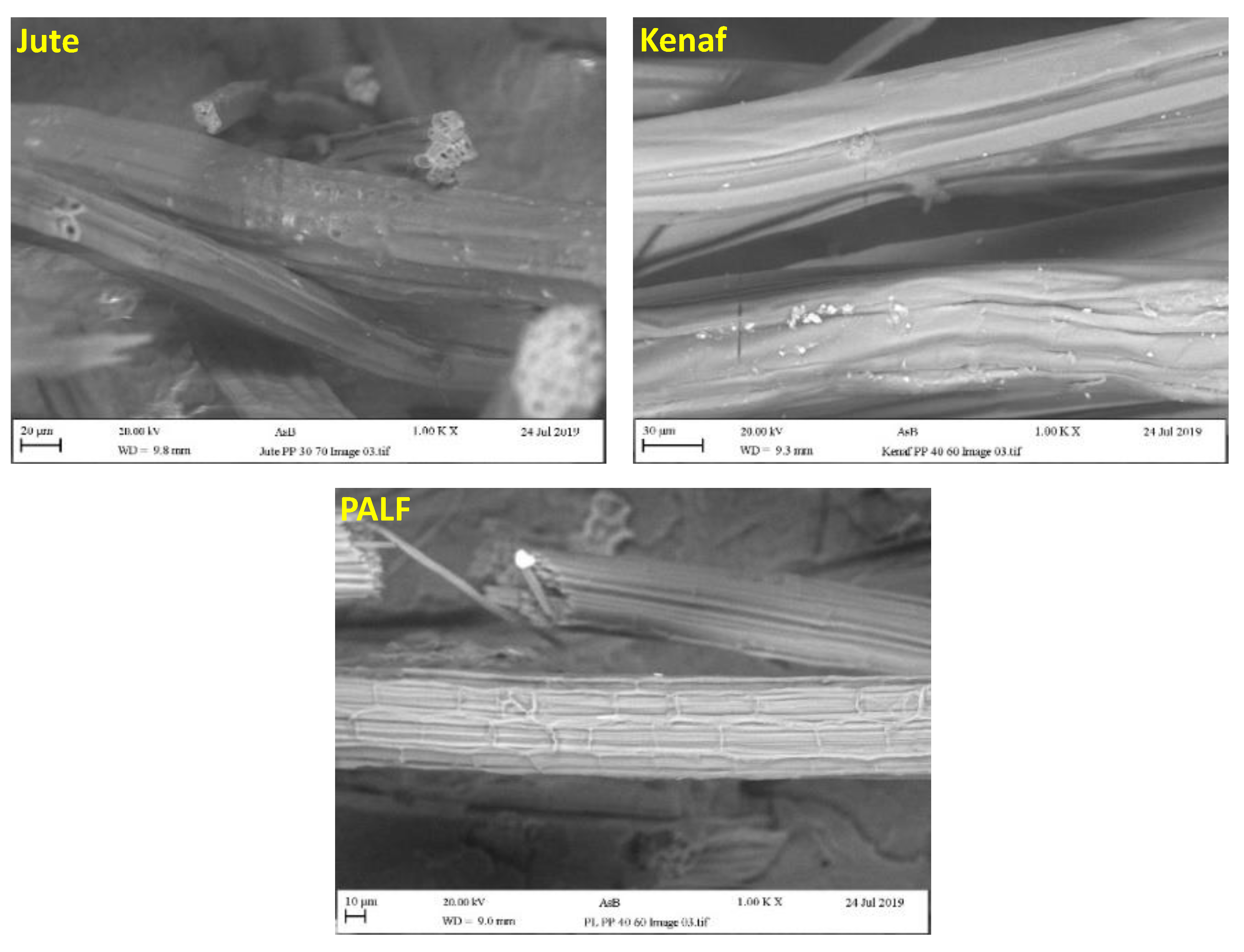
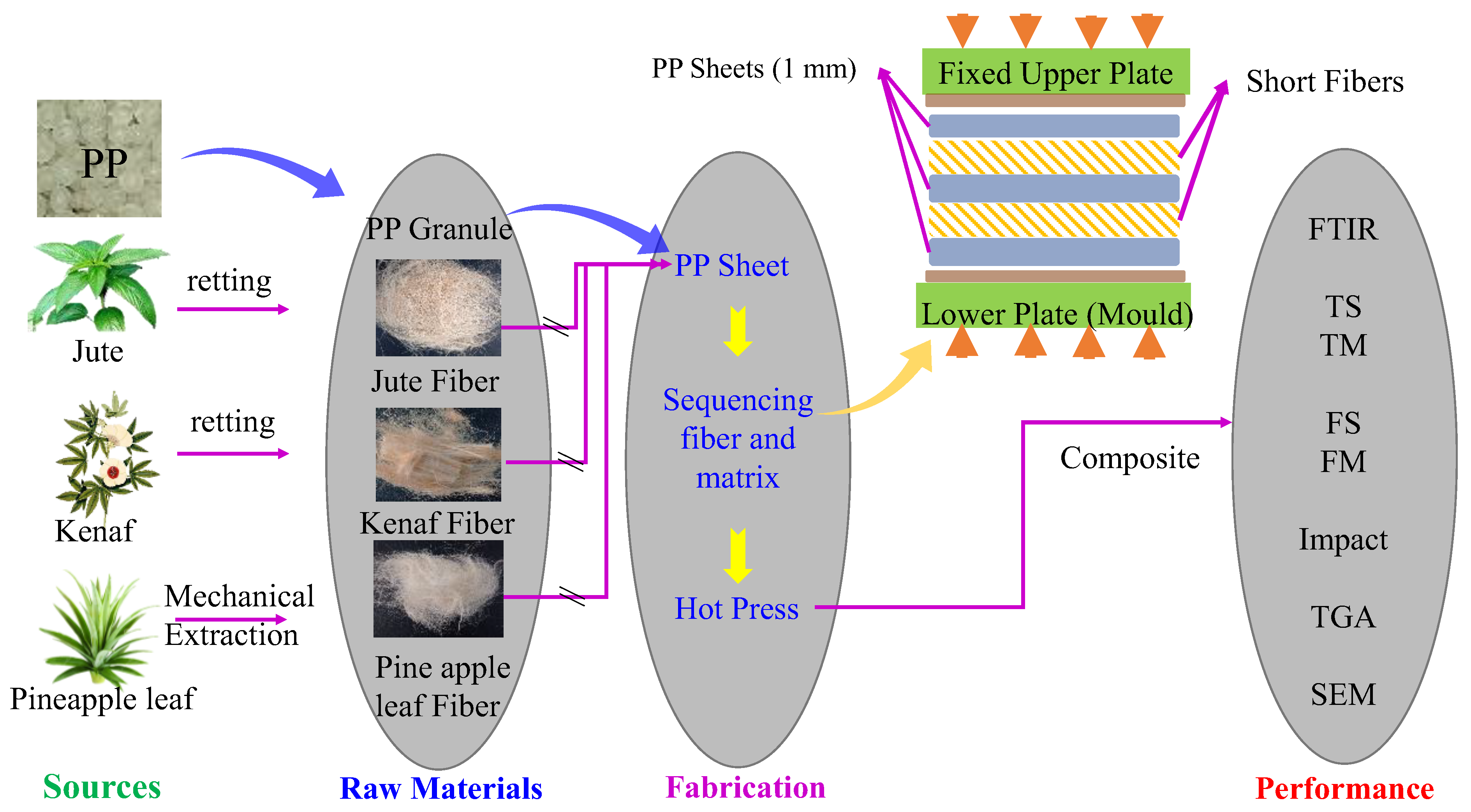
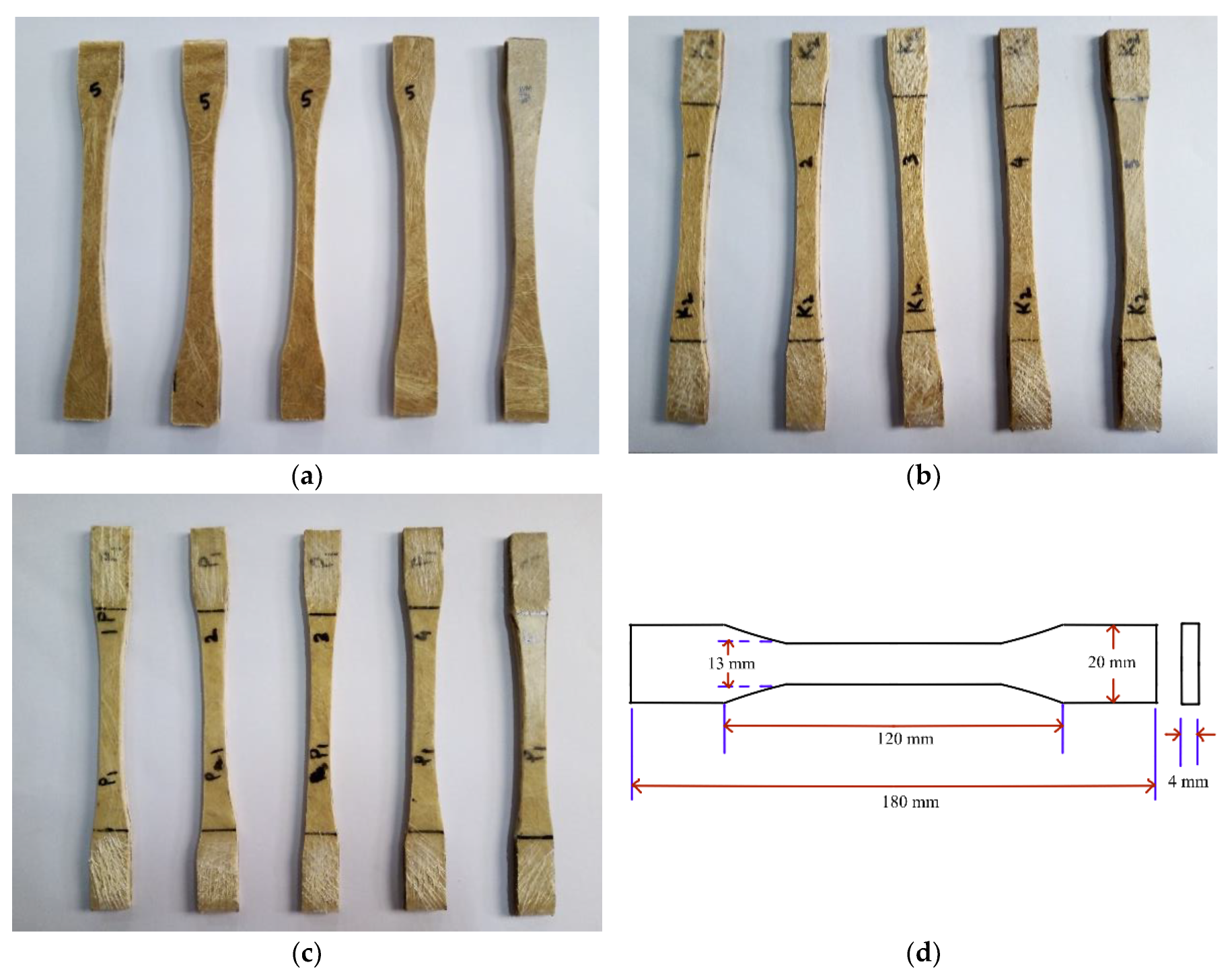
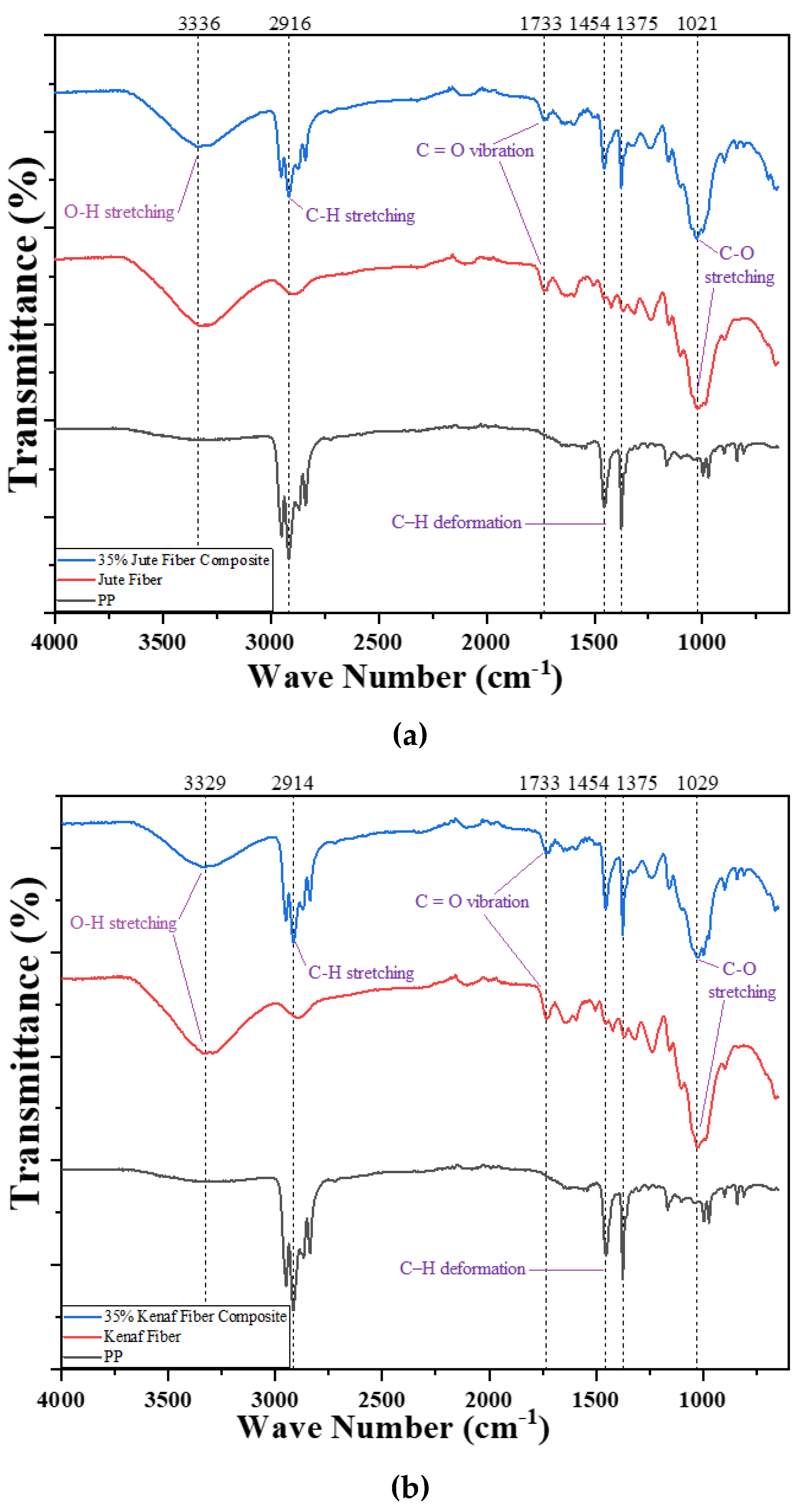


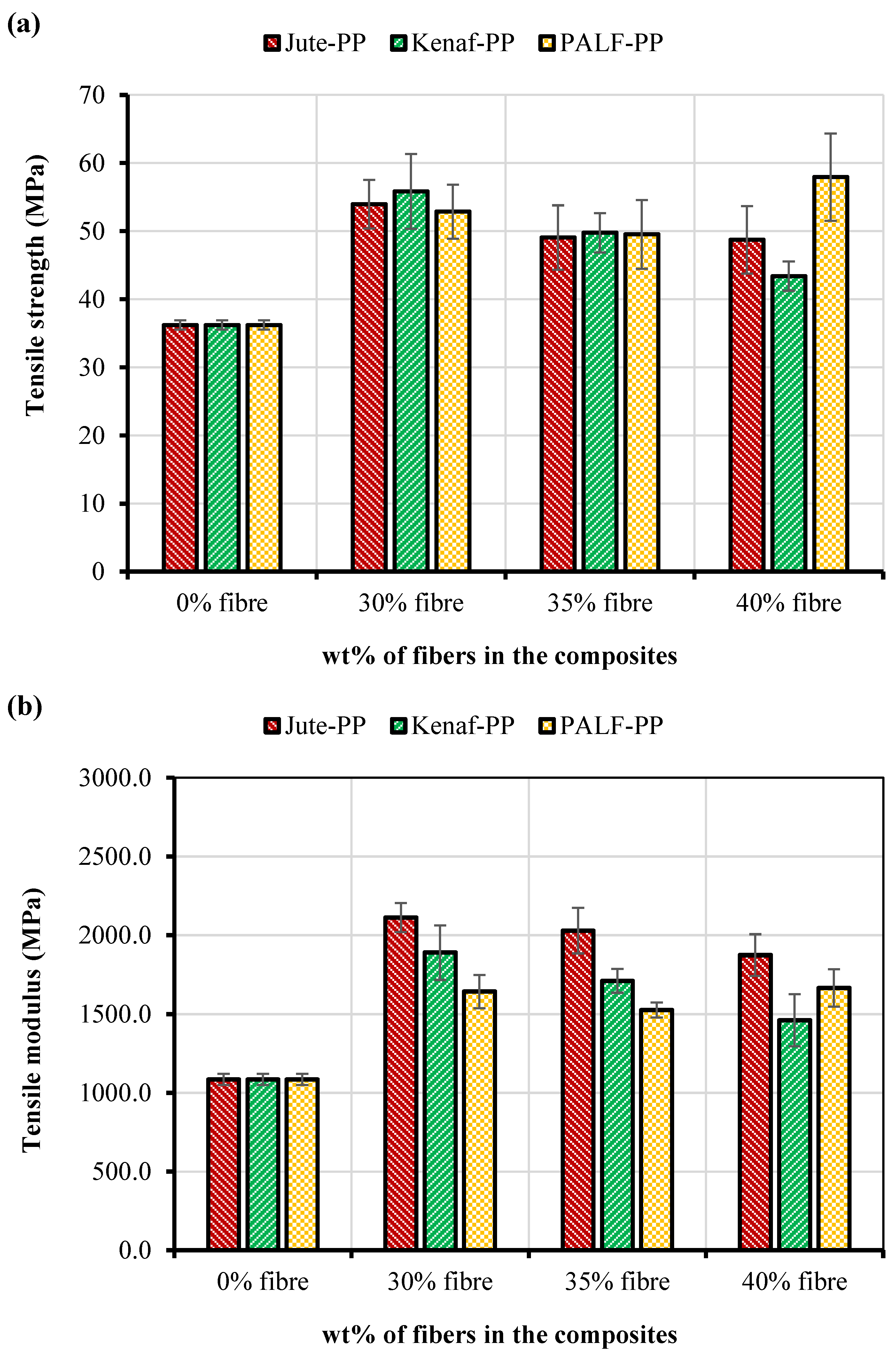

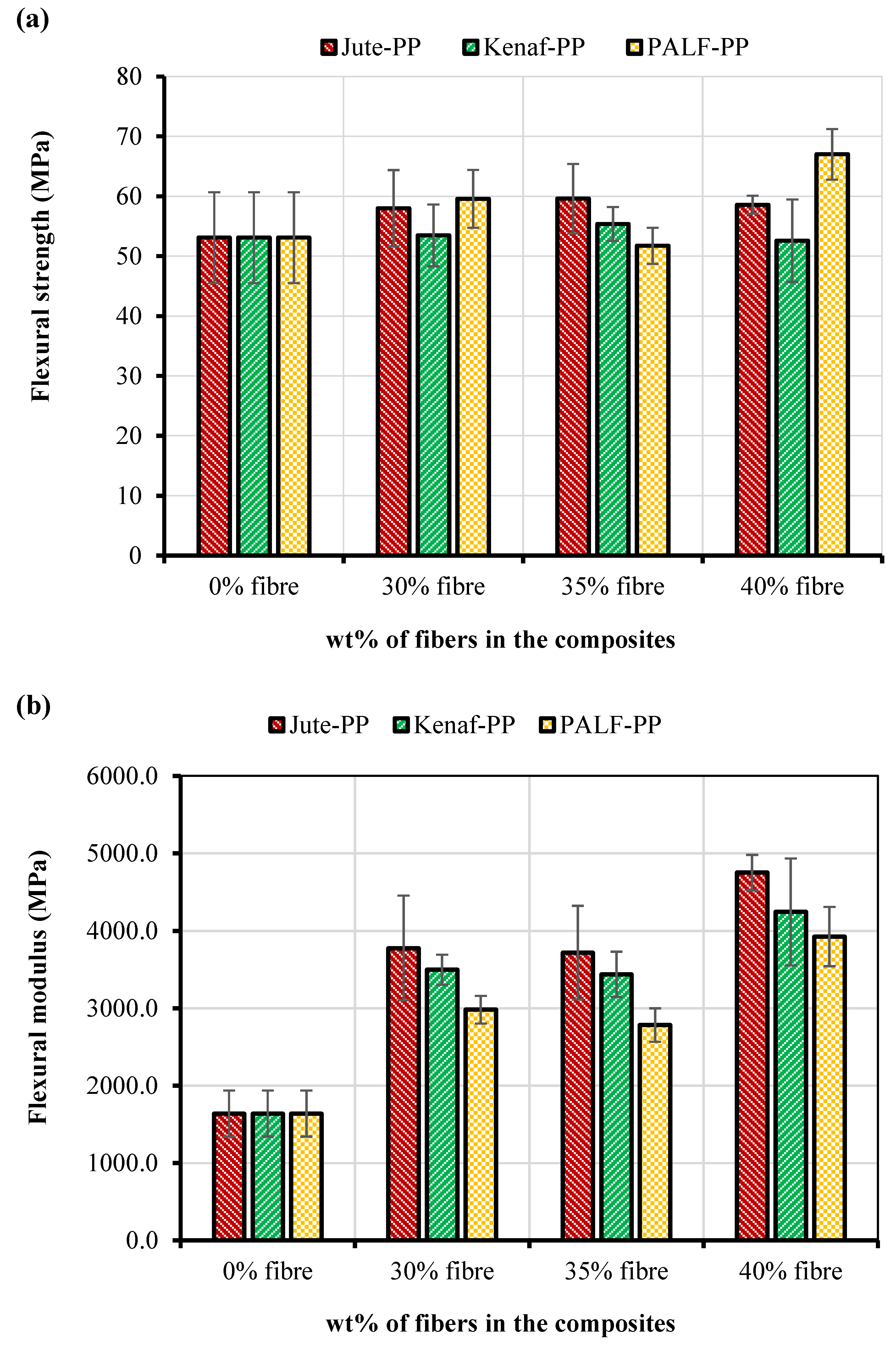

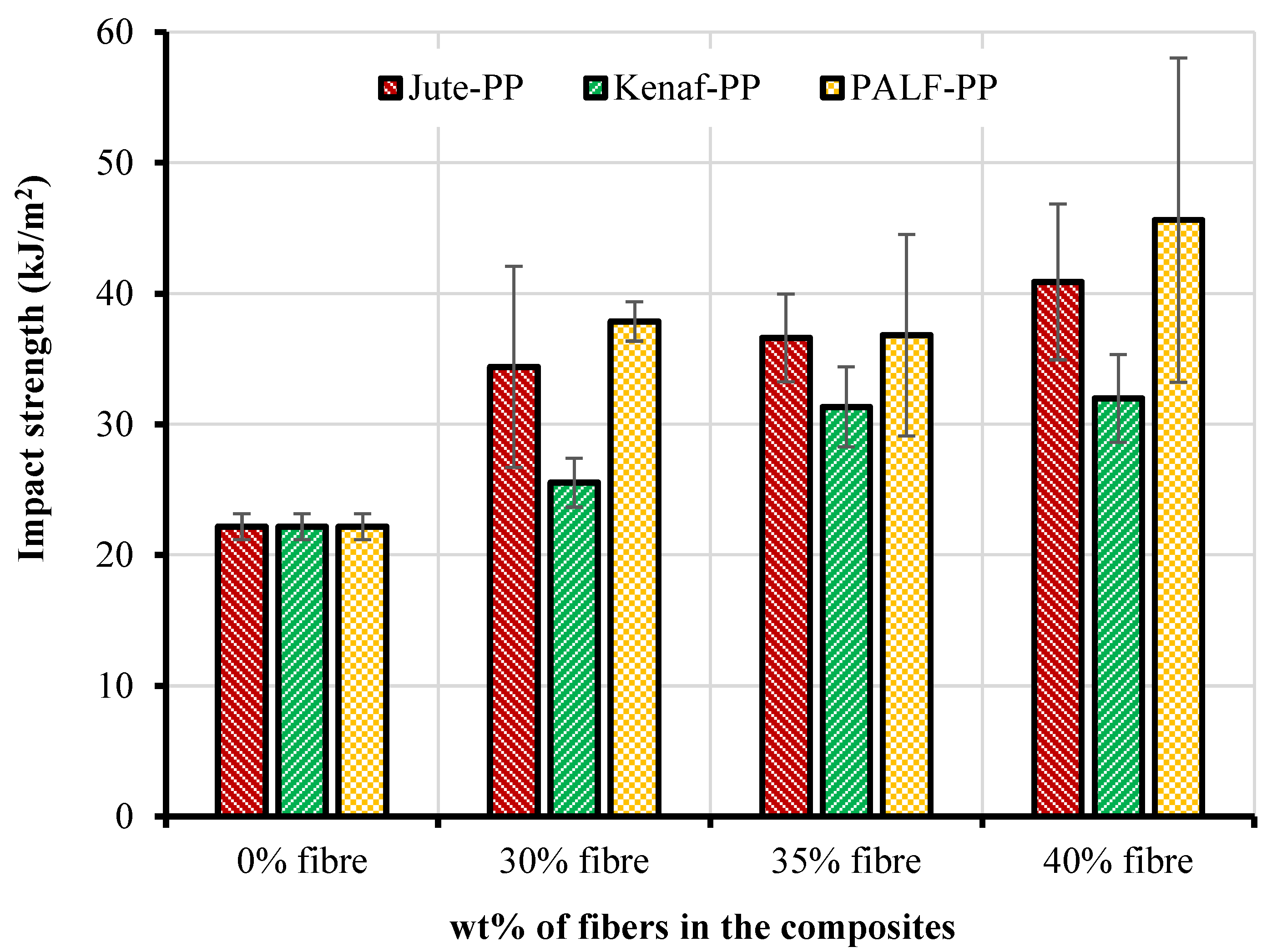
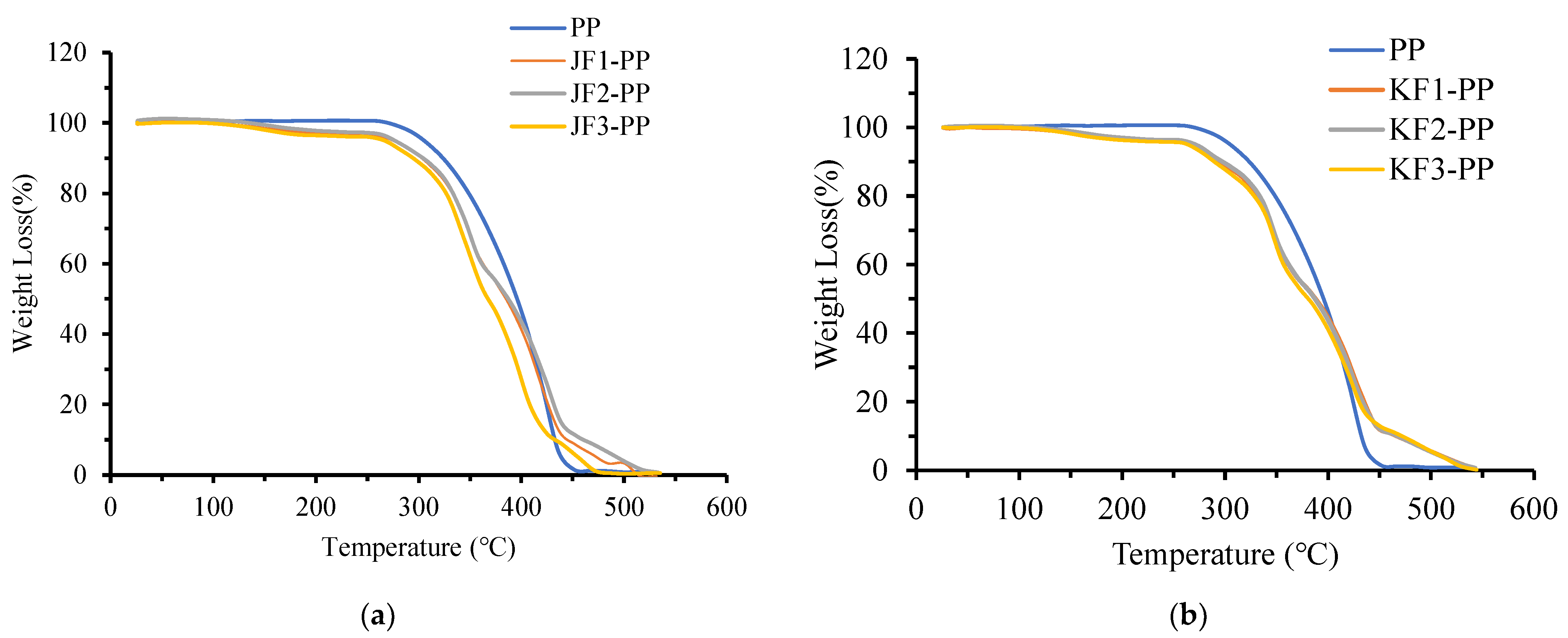
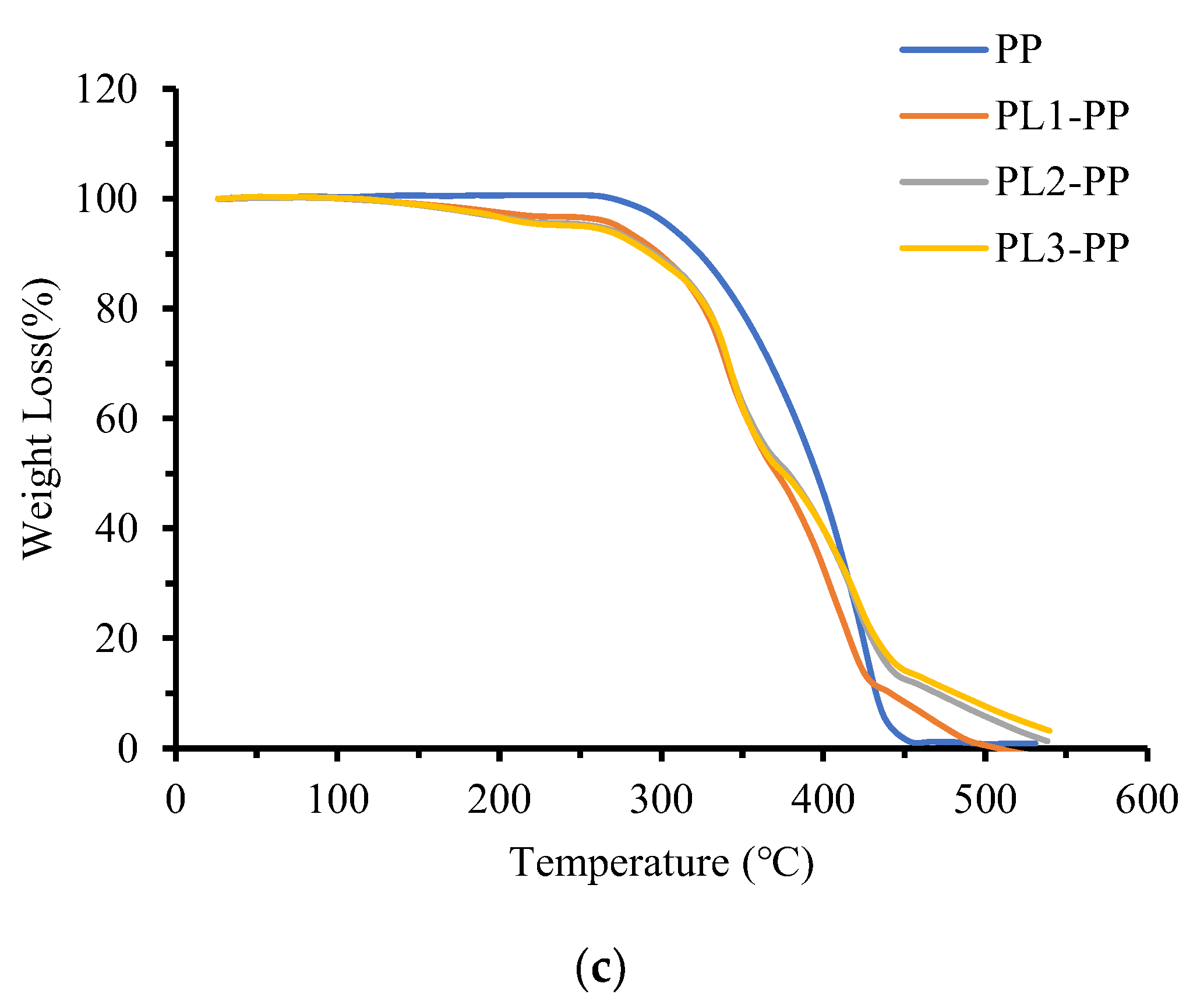
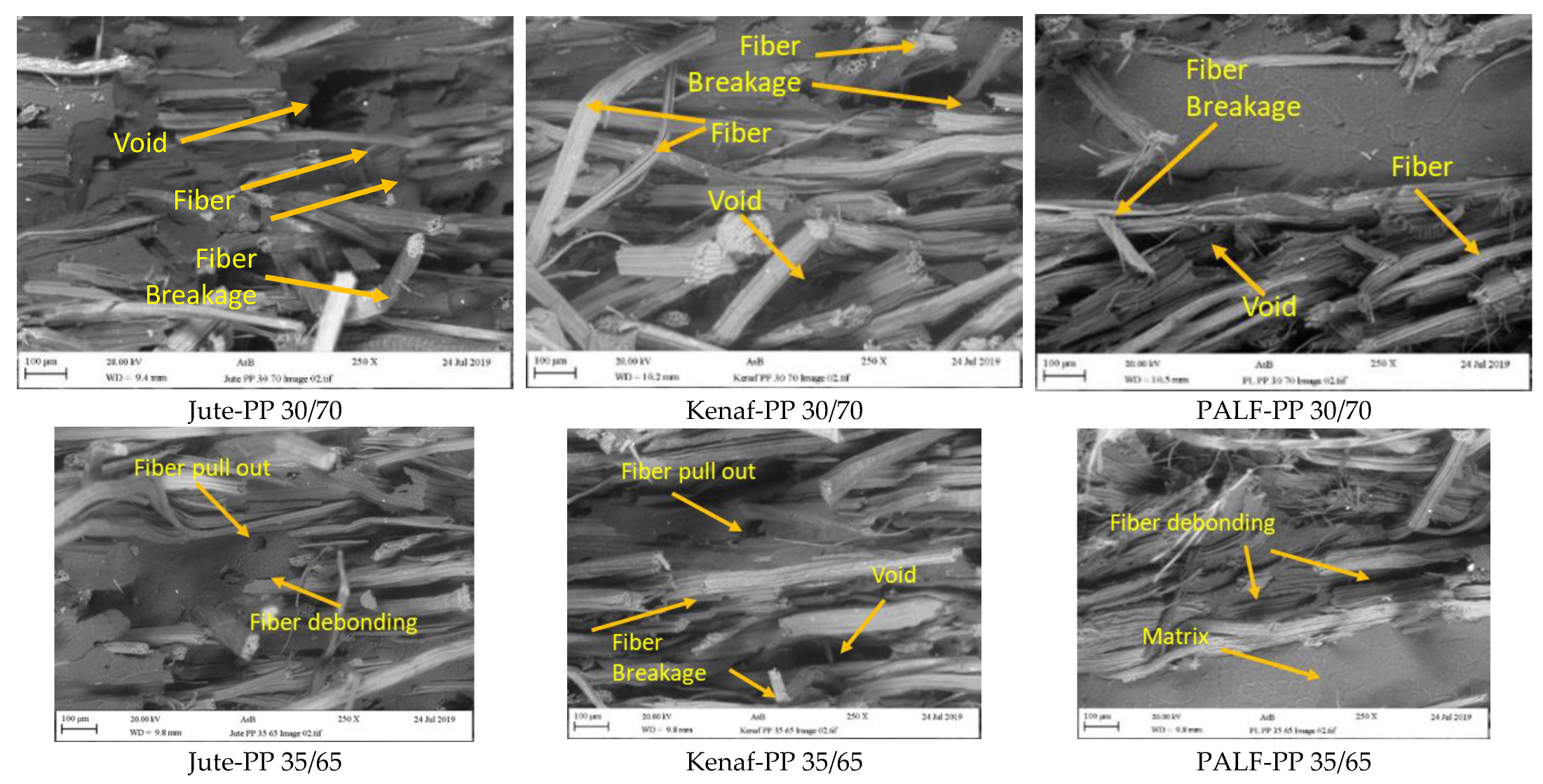



| Fibers | Composite | Mechanical/Range | Fiber Treatment | Fiber% | Fabrication | Ref. |
|---|---|---|---|---|---|---|
| Jute | Oxidized Jute-PP | TS increased (31–24 MPa), TM decreased (1.6–2.3 GPa), FS increased (44–56 GPa), IS increased (31–45 J/m), hardness increased (77–90) | Formic acid (HCOOH), sodium periodate solution, urea [CO(NH2)2] | 20–35% | Single screw extrusion | [19] |
| Jute fabrics-PP | TS (68.1 MPa) and BS (94.1 MPa) increased TM (2936 MPa) and BM (4831 MPa) increased, chemical absorption was high, IS increased | - | 30–55% | Compression molding | [20] | |
| Jute short fiber-PP | Water absorption rate was high for alkali treated composites, TS increased (21–30 MPa), TM increased (1.3–3 GPa) | Alkali, potassium permanganate, and silane | 30% | Twin Screw extrusion | [21] | |
| Jute fabrics-PP | TS increased (20.48–47.08 MPa), TM increased (1.24–3.58 GPa), | Nonpolar octyl gallate (OG), dodecyl gallate (DG), and octadecyl gallate (OCG) | 50% | Hot press | [22] | |
| PP/jute | TS and FS decreased with the addition of ESO and TOA, IS increased with the addition of ESO and TOA, | Epoxy soybean oil (ESO)/tung oil anhydride (TOA) | Torque rheometer followed by injection molded | [23] | ||
| Jute mat-PP-MAPP | TS increased for 30% MAPP (11.62–26.91 MPa) highest TM value shown for 20% MAPP (1590.73 MPa), FS increased (38.45–6.95 MPa) | - | 20–30% | Compression molding | [24] | |
| Jute fiber-PP | Storage modulus increased (580–1600 MPa), 2 ply of 3 cm jute fiber showed the highest TS (17.86 MPa), | - | 0–10% | Hot press | [25] | |
| Jute fiber-PP | Highest TS (25.8 MPa) and TM (1.7 GPa) for 40% jute-60%PP, highest FS (17.1 MPa) and FM (16.7 GPa) for 30% jute-70% PP, IS decreased (18–10KJ/m2), | - | 30–60% | Compression molding | [26] | |
| Kenaf (K) | MWCNT-K-PP | Viscosity decreased, TGA value is decreased (187–200 °C), water absorption stability increased, flammability is decreased, viscosity increased to 300–1600 Pa.S when MWCNT is added; when kenaf fiber incorporated viscosity increased 50–300 Pa | - | 10–40% | Injection molding | [27] |
| K-PP | The highest TS value (42 MPa) was shown for 5% NaOH treated 30% fiber content, TS value (58 MPa) increased for alkali–silane treated composites, TM (3 GPa) of alkali-silane treated composited was high than untreated and alkali treated composites Highest FS (55 MPa) was for 6% alkali-treated composites SEM examinations showed that TS and FS of composites increased for alkali treatment | NaOH, (alkali–silane treatment) | Compression molding | [28] | ||
| K-PP | Highest TS (48 MPa) was shown for 30% kenaf–PP composites, and flax-PP composites showed the highest FS (76 MPa) and specific modulus was highest for kenaf–PP composite | - | 30% and 40% | Compression molding | [29] | |
| K-PP-MH-MAgPP | Thermal stability decreased, TS decreased (40–23 MPa), TM (1.3–0.8) MPa increased, BS (65–108 MPa) decreased, and BM (6–10 GPa) increased with fiber content; with the addition of MgOH, TS (22–23 MPa) decreased, and BM (5–7 GPa) increased | - | 10–25% | Haake RheocordRPM is 50 | [30] | |
| K-PP | TS increased(25–50 MPa), TM increased (1–3 GPa), FS increased (31–70 MPa), FM increased (1.2–3.1 GPa), IS decreased (5.8–4.7 KJ/m2) | NaOH | 10–40% | Close molding injection | [31] | |
| K-PP | Correlation measured between the physical and mechanical properties | Alkaline, silane | - | Heat extrusion | [32] | |
| K-CNT-PP | Higher TS (16 MPa) shown for 30 wt%, TM increased (700–2200 MPa), FS increased (22–26 MPa), and FM increased (600–2400 MPa) | - | 20–40% | Injection molding | [33] | |
| K-PP | TS (158–85 MPa) decreased, TM (12200–7000 MPa) decreased with orientation of fiber and temperature (30–120 °C); BS (15–105 MPa) decreased, BM (1–8 GPa) decreased, and storage modulus (10–80 GPa) decreased and Poisson’s ratio (0.05–0.45) | - | 40% | Compression molding | [34] | |
| PALF | PALF- LDPE | TS (37–40 MPa), IS, BS, thermal stability are highest for 7% NaOH and 7.5 Gamma radiation, TM (1–1.6 GPa), TM (1.3–1.6 GPa), BS (91–97) MPa, | NaOH, gamma | 50% | Heat press | [35] |
| PALF-PP | Highest TS (42.2 MPa) and TM (1864 MPa) for untreated composites, TS (55.9 MPa) increased for ZnCl2 treatment, highest FS (51.6 MPa) shown for 40/60 weight percentage and for HNO3 treatment | Sodium Hydroxide (NaOH) solution, Zinc chloride, Acetic Anhydride and Nitric acid | 10–40% | Injection molding | [36] | |
| PALF-PP | TS (14.98 MPa) for 30% PALF | - | 10–30% | Twin-screw extrusion | [37] | |
| PALF-LDPE | TS increased (17–28 MPa), TM increased (400–800 MPa), BS increased (54–78 MPa), BM increased (1000–5800 MPa), highest impact strength was 33 KJ/m2 for 50% fiber weight | Gamma radiation | 10–60% | Compression molding | [38] | |
| PALF-PP | TS increased (28–87 MPa) TM increased (338–1731 MPa), BS increased (20–51 MPa), BM increased (230–840 MPa), IS increased (2.9–7.2 KJ/m2), | NaOH | 25–45% | Compression molding | [39] | |
| PALF-TBP | TS increased upto18.37 MPa with 30% fiber and TM increased to 1.03 GPa, BS increased to 19.34 MPa, IS increased to 18.10 kJ/m2 with 40% fiber | - | 10–40% | Compression molding | [40] | |
| PALF-PP | With 20 wt% PALF fibers, increase Young’s modulus (146%) and stress at break (112%), but decrease in elongation at break (298%) | - | - | Twin-screw extrusion | [41] | |
| PALF-PP/LDPE | Highest TS (54 MPa) for 15/85% PALF-PP composites and increased with the increase of PALF fiber | NaOH | 0–25% | Compression molding | [42] | |
| PALF-PP | TS (37.28 MPa) and TM (687.02 MPa) for 10.8% fiber content, FM (2000 MPa) was higher for 2.7% fiber content | - | 0–18% | Hot press | [43] |
| Types of Fiber/Matrix | Diameter (µm) | Density (gm/cm3) | Tensile Strength (MPa) | Tensile Modulus (GPa) |
|---|---|---|---|---|
| Jute | 53.38 ± 5.93 | 1.40 | 300–773 | 20–55 |
| Kenaf | 55–60 | 1.45 | 350–600 | 26.00 |
| PALF | 20–40 | 1.56 | 413–1627 | 60–82 |
| PP | - | 0.91 | 36.21 ± 0.68 | 1.085 ± 0.036 |
| Samples ID | Code | Fiber wt.% | Fiber Vf% |
|---|---|---|---|
| 30/70 Jute/PP Composite | JF1-PP | 30 | 21.60 |
| 35/65 Jute/PP Composite | JF2-PP | 35 | 25.71 |
| 40/60 Jute/PP Composite | JF3-PP | 40 | 30.00 |
| 30/70 Kenaf/PP Composite | KF1-PP | 30 | 20.45 |
| 35/65 Kenaf/PP Composite | KF2-PP | 35 | 24.41 |
| 40/60 Kenaf/PP Composite | KF3-PP | 40 | 28.57 |
| 30/70 PALF/PP Composite | PL1-PP | 30 | 26.49 |
| 35/65 PALF/PP Composite | PL2-PP | 35 | 31.17 |
| 40/60 PALF/PP Composite | PL3-PP | 40 | 35.92 |
| ID | Degradation Temperature, °C (T10%) | Degradation Temperature, °C (T20%) | Degradation Temperature,°C (T75%) | Degradation Temperature, °C (at T98%) |
|---|---|---|---|---|
| 100% PP | 323.31 | 348.51 | 420.23 | 500.11 |
| JF1-PP | 302.26 | 331.94 | 420.04 | 500.21 |
| JF2-PP | 303.60 | 332.80 | 426.01 | 531.57 |
| JF3-PP | 293.97 | 325.98 | 402.45 | 488.41 |
| KF1-PP | 294.86 | 331.17 | 428.24 | 541.17 |
| KF2-PP | 297.38 | 332.20 | 427.05 | 542.79 |
| KF3-PP | 289.67 | 327.46 | 424.09 | 544.13 |
| PL1-PP | 298.70 | 325.51 | 409.64 | 504.86 |
| PL2-PP | 295.01 | 327.46 | 422.61 | 538.35 |
| PL3-PP | 292.93 | 327.02 | 424.24 | 539.53 |
Disclaimer/Publisher’s Note: The statements, opinions and data contained in all publications are solely those of the individual author(s) and contributor(s) and not of MDPI and/or the editor(s). MDPI and/or the editor(s) disclaim responsibility for any injury to people or property resulting from any ideas, methods, instructions or products referred to in the content. |
© 2023 by the authors. Licensee MDPI, Basel, Switzerland. This article is an open access article distributed under the terms and conditions of the Creative Commons Attribution (CC BY) license (https://creativecommons.org/licenses/by/4.0/).
Share and Cite
Sayeed, M.M.A.; Sayem, A.S.M.; Haider, J.; Akter, S.; Habib, M.M.; Rahman, H.; Shahinur, S. Assessing Mechanical Properties of Jute, Kenaf, and Pineapple Leaf Fiber-Reinforced Polypropylene Composites: Experiment and Modelling. Polymers 2023, 15, 830. https://doi.org/10.3390/polym15040830
Sayeed MMA, Sayem ASM, Haider J, Akter S, Habib MM, Rahman H, Shahinur S. Assessing Mechanical Properties of Jute, Kenaf, and Pineapple Leaf Fiber-Reinforced Polypropylene Composites: Experiment and Modelling. Polymers. 2023; 15(4):830. https://doi.org/10.3390/polym15040830
Chicago/Turabian StyleSayeed, M. M. Alamgir, Abu Sadat Muhammad Sayem, Julfikar Haider, Sharmin Akter, Md. Mahmudul Habib, Habibur Rahman, and Sweety Shahinur. 2023. "Assessing Mechanical Properties of Jute, Kenaf, and Pineapple Leaf Fiber-Reinforced Polypropylene Composites: Experiment and Modelling" Polymers 15, no. 4: 830. https://doi.org/10.3390/polym15040830
APA StyleSayeed, M. M. A., Sayem, A. S. M., Haider, J., Akter, S., Habib, M. M., Rahman, H., & Shahinur, S. (2023). Assessing Mechanical Properties of Jute, Kenaf, and Pineapple Leaf Fiber-Reinforced Polypropylene Composites: Experiment and Modelling. Polymers, 15(4), 830. https://doi.org/10.3390/polym15040830











